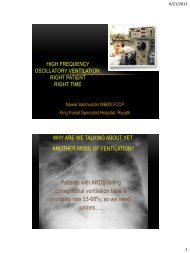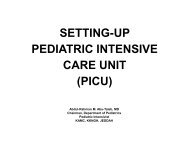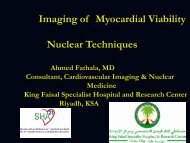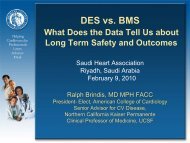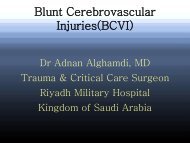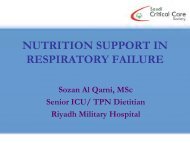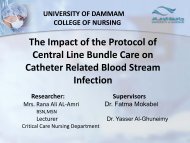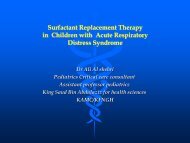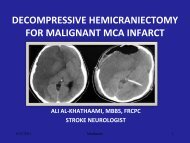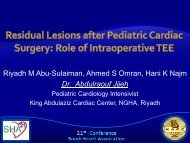Valuing Nurses, Valuing Partnerships - RM Solutions
Valuing Nurses, Valuing Partnerships - RM Solutions
Valuing Nurses, Valuing Partnerships - RM Solutions
Create successful ePaper yourself
Turn your PDF publications into a flip-book with our unique Google optimized e-Paper software.
Neonatal Intensive Care Unit<br />
(NICU)Nursing Shortage:<br />
<strong>Valuing</strong> <strong>Nurses</strong>,<br />
<strong>Valuing</strong> <strong>Partnerships</strong><br />
Fiona Haines, RN, BCur, ADM<br />
Coordinator, Magnet® Recognition Program<br />
King Faisal Specialist Hospital & Research Center (General Organization) – Jeddah Branch
Objectives<br />
• To present an overview of the<br />
challenges with nurse shortages<br />
• To present the journey of the NICU in<br />
addressing some these challenges
December 2006
Goals of the Magnet® Program<br />
The focus is on advancing three goals:<br />
1. Promoting quality in a setting that<br />
supports professional practice<br />
2. Identifying excellence in the delivery<br />
of nursing services to patients<br />
3. Disseminating “best practices” in<br />
nursing services.<br />
American <strong>Nurses</strong> Credentialing Center, 2009
Magnet® Hospitals<br />
Attraction and<br />
Retention of<br />
Professional<br />
<strong>Nurses</strong><br />
McClure, Poulin, Sovie & Wandelt,<br />
1983<br />
American Academy of Nursing<br />
Two decades of Magnet ®<br />
Hospital studies
Magnetism for Staff<br />
<strong>Nurses</strong><br />
• Clinically competent<br />
colleagues<br />
• Good Nurse-Physician<br />
relationships<br />
• Good communication<br />
• Nurse autonomy &<br />
accountability<br />
• Supportive nurse manager /<br />
supervisor<br />
• Control over nursing<br />
practice / environment<br />
• Support of education<br />
• Adequate nurse staffing<br />
• Concern for patient is<br />
paramount!<br />
(Kramer and Schmalenberg, 2002)
Nurse Outcomes<br />
• Decreased turnover of nurses.<br />
• Significantly lower burnout for nurses.<br />
• Significantly higher job satisfaction<br />
• Increased reporting of ability to provide quality care to<br />
patients<br />
• Decreased injuries (e.g. needle sticks, back injuries) for<br />
nurses.<br />
(Needleman, Buerhaus, Mattke, Stewart and Zelevinsky, 2001)
Patient Outcomes<br />
• Lower hospital mortality rates primarily due to<br />
higher nurse/patient ratios<br />
• Lower hospital complications credited to higher<br />
nurse staffing<br />
• Less “Failure-to-Rescue” with greater surveillance<br />
capability<br />
• Greater patient satisfaction<br />
Needleman, Buerhaus, Mattke, Stewart and Zelevinsky, 2001)
MAGNET® ACCREDITTED HOSPITALS<br />
Total 2010 372<br />
USA 367 (6.3%)<br />
New Zealand 1 2007<br />
Australia 2 2005<br />
2009<br />
Lebanon (AUB) 1 2009<br />
Singapore 1 2010
Magnet® Recognition<br />
Program,2008
Magnet® Recognition<br />
Program,2008<br />
Structural<br />
Empowerment<br />
Transformational<br />
Leadership<br />
Empirical<br />
Outcomes<br />
Exemplary<br />
Professional<br />
Practice<br />
New Knowledge<br />
Innovations &<br />
Improvement
Shared decision making<br />
is the glue that holds the<br />
partnership together<br />
Dr Sandy Lovering, Chief , Nursing Affairs,<br />
Nov 2008
Bridging Cultures through Shared Values
<strong>Valuing</strong> <strong>Nurses</strong>,<br />
<strong>Valuing</strong> Partnership
Leadership Role<br />
Shared<br />
Decision<br />
Making<br />
Direct Care<br />
Nurse<br />
engagement<br />
Leadership<br />
development<br />
NDNQI RN Satisfaction Survey workshop:<br />
Head Nurse and Staff <strong>Nurses</strong> reviewing their<br />
results
Autonomy &<br />
Decision Making<br />
Audit & Observation by Peers
NICU Results
Magnet® Recognition<br />
Program,2008<br />
Structural<br />
Empowerment<br />
Transformational<br />
Leadership<br />
Empirical<br />
Outcomes<br />
Exemplary<br />
Professional<br />
Practice<br />
New Knowledge<br />
Innovations &<br />
Improvement
Professional<br />
Development<br />
• Opportunities to advance<br />
• NICU Course<br />
• Critical Care Post Graduate<br />
certification<br />
• Scholarship Program<br />
• Nursing Grand Rounds<br />
• In-Service Training<br />
• Professional Organization<br />
membership<br />
• On-Line Courses<br />
The first NICU Course graduates
Recognition &<br />
Reward<br />
1.Unit :<br />
• Unit program<br />
• Certificates<br />
2.Organizational:<br />
• Portfolios<br />
• DAISY award<br />
Ronel, RN, SN1, UC member attending<br />
Strategic Planning Retreat, 2010
Participation in Local, National &<br />
International Conferences
Professional Practice<br />
Model
Unit Councils<br />
SHARED DECISION MAKING<br />
<br />
<br />
<br />
<br />
Practice<br />
Quality<br />
Professional<br />
Development<br />
Facilitation by<br />
Manager &<br />
Clinical Nurse<br />
Coordinator
Magnet® Recognition<br />
Program,2008<br />
Structural<br />
Empowerment<br />
Transformational<br />
Leadership<br />
Empirical<br />
Outcomes<br />
Exemplary<br />
Professional<br />
Practice<br />
New Knowledge<br />
Innovations &<br />
Improvement
The Crescent of Caring<br />
Dr Sandy Lovering,<br />
Doctorate Thesis,<br />
Nov 2008<br />
Components of care<br />
Spiritual care<br />
Psycho social care<br />
Cultural care<br />
Interpersonal care<br />
Clinical care<br />
Cultural, Professional<br />
and Spiritual values<br />
impact on professional<br />
nurse caring and the<br />
patient / family<br />
perspective
Quality Indicators<br />
Structure<br />
• Staffing<br />
• Qualifications<br />
• Training &<br />
Education<br />
Process<br />
• PU IHI<br />
prevention<br />
bundle<br />
• Falls<br />
• VAP bundle<br />
• BSI, CAUTI<br />
bundle *<br />
• Documentation<br />
Outcomes<br />
• HAPU incidence<br />
• Falls incidence<br />
• Infections incidence<br />
• Peripheral infiltrations (Peds)*<br />
• Prevalence “snapshot”<br />
• Pressure ulcers<br />
• Restraints<br />
• Nurse Turnover<br />
• Job satisfaction<br />
• Patient Satisfaction
Percent of Surveyed Patients with Hospital Acquired Pressure Ulcers<br />
Level III Neonatal - Critical Care 1Q09 2Q09 3Q09 4Q09 1Q10 2Q10 3Q10 4Q10 Avg<br />
Neonatal ICU 0.00 0.00 0.00 0.00 0.00 0.00 0.00<br />
Hospital Level III Neonatal - Critical Care<br />
Median 0.00 0.00 0.00 0.00 0.00 0.00 0.00<br />
National Comparative Information - All Hospitals<br />
Mean 2.17 1.38 2.22 1.13 1.36 2.05 1.72<br />
S.D. 5.50 5.93 10.32 4.25 4.68 9.42 6.68<br />
10th Percentile 0.00 0.00 0.00 0.00 0.00 0.00 0.00<br />
25th Percentile 0.00 0.00 0.00 0.00 0.00 0.00 0.00<br />
50th Percentile (median) 0.00 0.00 0.00 0.00 0.00 0.00 0.00<br />
75th Percentile 0.00 0.00 0.00 0.00 0.00 0.00 0.00<br />
90th Percentile 7.14 1.89 2.78 2.78 4.44 4.55 3.93<br />
# of Reporting Units¹ 42 66 87 105 129 131 93.33<br />
Level III Neonatal -<br />
Critical Care<br />
% Receiving Each Intervention²<br />
Skin<br />
Assmt PRS Repos<br />
Nutr<br />
Supp<br />
Moist<br />
Mgmt<br />
Neonatal ICU 100.00 100.00 100.00 100.00 100.00<br />
National Comparative Information - Bed Size 200 - 299<br />
Mean 90.63 83.88 95.77 90.63 63.81<br />
S.D. 27.20 30.89 12.58 27.20 46.72<br />
10th Percentile 50.00 37.50 89.74 50.00 0.00<br />
25th Percentile 100.00 77.27 100.00 100.00 3.85<br />
50th Percentile<br />
(median) 100.00 100.00 100.00 100.00 100.00<br />
75th Percentile 100.00 100.00 100.00 100.00 100.00<br />
90th Percentile 100.00 100.00 100.00 100.00 100.00<br />
National Database of Nursing Quality Indicators ®
Central Line Associated Blood Stream Infections per 1000 Central<br />
Line Days, by Birth Weight Category<br />
4th Quarter 2010<br />
Level III Neonatal - Critical Care 2500 g.<br />
Neonatal ICU 0.00 0.00 0.00 0.00 0.00<br />
Hospital Level III Neonatal -<br />
Critical Care Median 0.00 0.00 0.00 0.00 0.00<br />
National Comparative Information - Bed Size 200 - 299<br />
Mean 2.61 1.22 0.28 1.19 0.35<br />
S.D. 6.18 3.63 1.46 3.96 1.76<br />
10th Percentile 0.00 0.00 0.00 0.00 0.00<br />
25th Percentile 0.00 0.00 0.00 0.00 0.00<br />
50th Percentile (median) 0.00 0.00 0.00 0.00 0.00<br />
75th Percentile 0.00 0.00 0.00 0.00 0.00<br />
90th Percentile 10.70 3.63 0.00 2.00 0.00<br />
# of Reporting Units¹ 38 43 45 47 48<br />
National Database of Nursing Quality Indicators ®
Ventilator Associated Pneumonias per 1000 Ventilator<br />
Days, by Birth Weight Category<br />
Level III Neonatal - Critical Care 2500 g.<br />
Neonatal ICU 0.00 0.00 0.00 0.00 0.00<br />
Hospital Level III Neonatal - Critical<br />
Care Median 0.00 0.00 0.00 0.00 0.00<br />
National Comparative Information - Bed Size 200 - 299<br />
Mean 1.89 1.58 0.22 0.00 0.00<br />
S.D. 5.21 4.43 1.17 0.00 0.00<br />
10th Percentile 0.00 0.00 0.00 0.00 0.00<br />
25th Percentile 0.00 0.00 0.00 0.00 0.00<br />
50th Percentile (median) 0.00 0.00 0.00 0.00 0.00<br />
75th Percentile 0.00 0.00 0.00 0.00 0.00<br />
90th Percentile 7.82 8.35 0.00 0.00 0.00<br />
# of Reporting Units¹ 30 30 29 35 33<br />
National Database of Nursing Quality Indicators ®
Magnet® Recognition<br />
Program,2008<br />
Structural<br />
Empowerment<br />
Transformational<br />
Leadership<br />
Empirical<br />
Outcomes<br />
Exemplary<br />
Professional<br />
Practice<br />
New<br />
Knowledge<br />
Innovations &<br />
Improvement
Evidence Based<br />
Practice<br />
• EBP Education<br />
• Email Access all staff<br />
• Approach<br />
Multidisciplinary<br />
• Completed Projects:<br />
1. Diaper Rash: 2010<br />
2. Conjunctivitis : 2010<br />
• Current: 2011:<br />
1. Nasal Septum PU<br />
Maternal Child Divisional Council
Diaper Rash:<br />
Outcomes<br />
• Standardized assessment/staging<br />
• Education and skills assessment all new employees and<br />
current employees<br />
• Intensive Root-Cause Analysis & Case Reviews<br />
• Collaboration with pharmacy to acquire optimal barrier<br />
creams (Sudocream replaced Proskin)<br />
• Continuous monitoring: increased reporting due to<br />
increased awareness and continuous improvement of<br />
practice
Neonatal Conjunctivitis:<br />
Outcomes<br />
• Multidisciplinary project (in collaboration Infection Control)<br />
• High risk groups identified (premature with nasal prongs;<br />
premature with eye examinations for potential retinopathy<br />
etc.)<br />
• Policy and practice review<br />
• Increased vigilance with assessment<br />
• Education and skills review<br />
• Continuous monitoring for incidence
Magnet® Recognition<br />
Program,2008<br />
Structural<br />
Empowerment<br />
Transformational<br />
Leadership<br />
Empirical<br />
Outcomes<br />
Exemplary<br />
Professional<br />
Practice<br />
New Knowledge<br />
Innovations &<br />
Improvement
Total Nursing Unit Turnover Rate as % of Employed FTEs<br />
% Separated Number of RN and APRN<br />
Staff<br />
Level III Neonatal - Critical Care 1Q10 2Q10 3Q10 4Q10<br />
Four<br />
Quarter<br />
Rate<br />
Neonatal ICU 2.50 0.00 2.48 4.96 9.94<br />
Hospital Level III Neonatal - Critical Care<br />
Median 2.50 0.00 2.48 4.96 9.94<br />
National Comparative Information - Bed Size 200 - 299<br />
Mean 3.03 3.39 3.33 3.46 11.56<br />
S.D. 2.92 4.93 4.00 5.01 8.37<br />
10th Percentile 0.00 0.00 0.00 0.00 0.00<br />
25th Percentile 0.00 0.00 0.00 0.00 7.23<br />
50th Percentile (median) 2.74 2.08 2.69 1.50 9.72<br />
75th Percentile 4.48 4.66 5.04 5.58 16.89<br />
90th Percentile 8.22 8.49 6.80 9.38 20.67<br />
# of Reporting Units¹ 35 30 35 35 26.00<br />
Magnet Controllable<br />
Reasons Turnover (% of<br />
All Reasons)<br />
4th Quarter 2010<br />
Adapted-NQF Voluntary Reasons for Turnover<br />
Dissatisfaction or conflict<br />
with team/management or<br />
lack of respect<br />
Employee initiated move<br />
from area or job related<br />
injury/ disability/illness<br />
Level III Neonatal -<br />
Inability to Staffing or<br />
Dissatisfaction with<br />
Critical Care<br />
Pay advance workload<br />
work environment<br />
Neonatal ICU 0.00 0.00 0.00 0.00 0.00 0.00<br />
Hospital Level III Neonatal -<br />
Critical Care Median 0.00 0.00 0.00 0.00 0.00 0.00<br />
National Database of Nursing Quality Indicators ®
Holistically Caring<br />
for the Family<br />
Shared Decision<br />
Making<br />
Team Work &<br />
<strong>Partnerships</strong><br />
Quality Outcomes &<br />
Evidence Based Care<br />
Supportive<br />
Environment<br />
Competent <strong>Nurses</strong>
Acknowledgements<br />
• Dr Sandy Lovering, for her contribution to this presentation<br />
• The Multidisciplinary team of the NICU, KFSHRC(Gen. Org.)-<br />
Jeddah Branch, without whom this presentation would not<br />
be possible<br />
• Barbara Janse Van Vuuren, QI Coordinator for the KPI<br />
results<br />
• All whose photographs appear in this presentation<br />
• My review team for their invaluable assistance, thank you
Magnet® Hospital<br />
Studies<br />
• “Superior outcomes for Magnet® Hospitals: the<br />
evidence” Aiken and colleagues relating Work<br />
Environments to Patient and Nurse Outcomes.<br />
• “Essentials of Magnetism for Staff <strong>Nurses</strong>” Kramer &<br />
Schmalenberg (2001)<br />
• “Keeping Patients Safe: Transforming the Work<br />
Environment of <strong>Nurses</strong>”, Institute of Medicine Report<br />
(2004)
Contact Information<br />
• Liza Cronje, Head Nurse, NICU:<br />
Email: LCronje@kfshrc.edu.sa<br />
• Fiona Haines<br />
Email: FHaines@kfshrc.edu.sa



